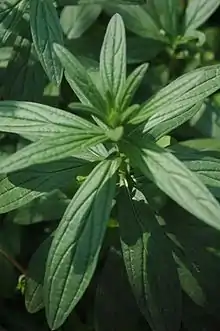Lithospermum erythrorhizon
Lithospermum erythrorhizon, commonly called purple gromwell, red gromwell, red-root gromwell and redroot lithospermum, is a plant species in the genus Lithospermum.[1] It is called zǐcǎo (紫草) in Chinese, jichi (지치) in Korean, and murasaki (ムラサキ; 紫) in Japanese.[1]
| Lithospermum erythrorhizon | |
|---|---|
 | |
| Leaves | |
| Scientific classification | |
| Kingdom: | Plantae |
| Clade: | Tracheophytes |
| Clade: | Angiosperms |
| Clade: | Eudicots |
| Clade: | Asterids |
| Order: | Boraginales |
| Family: | Boraginaceae |
| Genus: | Lithospermum |
| Species: | L. erythrorhizon |
| Binomial name | |
| Lithospermum erythrorhizon Siebold & Zucc. 1846 | |

The dried root of Lithospermum erythrorhizon (lithospermum root or Lithospermi Radix) is a Chinese herbal medicine with various antiviral and biological activities, including inhibition of human immunodeficiency virus type 1 (HIV-1).[2][3]
Biochemistry
The enzyme 4-hydroxybenzoate geranyltransferase utilizes geranyl diphosphate and 4-hydroxybenzoate to produce 3-geranyl-4-hydroxybenzoate and diphosphate. Biosynthetically, alkannin is produced in plants from the intermediates 4-hydroxybenzoic acid and geranyl pyrophosphate. This enzyme is involved in shikonin biosynthesis.
The enzyme geranylhydroquinone 3''-hydroxylase uses geranylhydroquinone, NADPH, H+ and O2 to produce 3-hydroxygeranylhydroquinone, NADP+ and H2O.
Culture
It has been cultivated in Japan since the Nara period for its root, which can be used for herbal medicine and to make dyes.
One Japanese word for the plant, murasaki (紫), inspired the pen name "Lady Murasaki" for the author of The Tale of Genji and is also the source of the general Japanese term for the color purple, murasaki iro (紫色).
The dyes made from its root also had other names, such as shikon (紫根), but all of them were difficult to work with because of their requirement for an alum-rich mordant and the resulting colors' extreme vulnerability to photobleaching. During the Heian Period, sumptuary laws restricted murasaki-dyed clothing to the Empress and her ladies in waiting.
See also
References
- "Lithospermum erythrorhizon". Germplasm Resources Information Network (GRIN). Agricultural Research Service (ARS), United States Department of Agriculture (USDA).
- Chen, X., et al. (2003). Shikonin, a component of Chinese herbal medicine, inhibits chemokine receptor function and suppresses human immunodeficiency virus type 1. Antimicrobial Agents and Chemotherapy 47(9), 2810-16.
- Gao, H., et al. (2011). Anti-adenovirus activities of shikonin, a component of Chinese herbal medicine in vitro. Biol Pharm Bull. 34(2) 197-202.
- Dalby, Liza (2001). Kimono: Fashioning Culture.University of Washington Press, pp. 236–237. ISBN 0-295-98155-5.
- Wada Yoshiko; Mary Kellogg Rice, and Jane Barton (1983). Shibori: The Inventive Art of Japanese Shaped Resist Dyeing. Kodansha, pp. 278–279. ISBN 0-87011-559-6.
- http://www.aisf.or.jp/~jaanus/deta/m/murasaki.htm Retrieved on 2007-04-20.
- McGann, Kass (2003), Things to Wear — A History of Japanese Clothing: Japanese Dyestuffs, retrieved 2007-04-20
External links
| Wikispecies has information related to Lithospermum erythrorhizon. |
| Wikimedia Commons has media related to Lithospermum erythrorhizon. |
